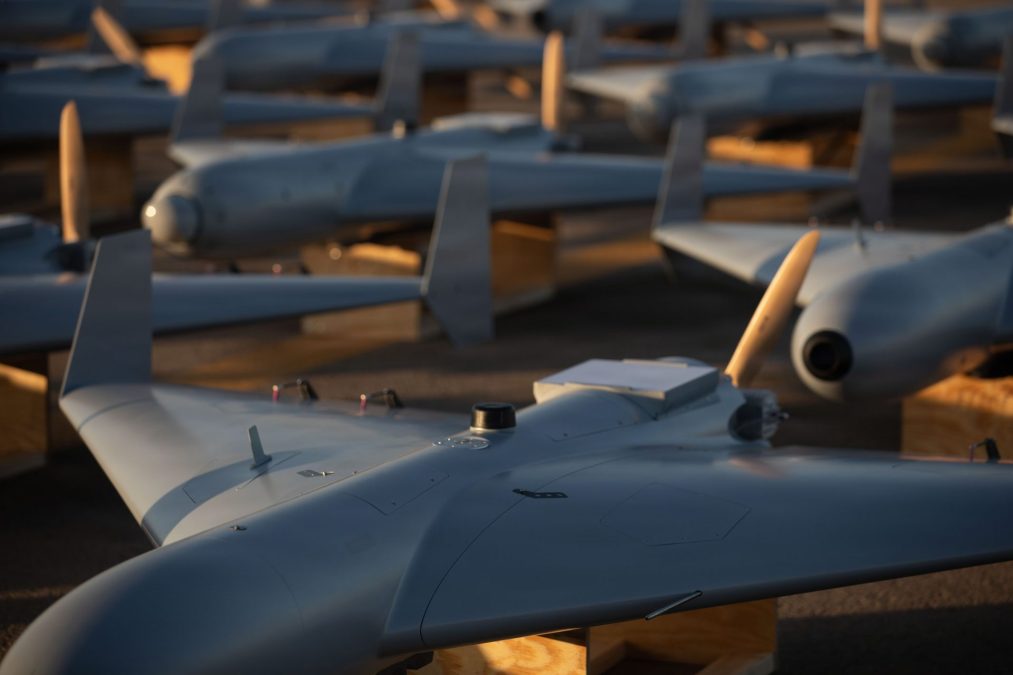When Evan Strickland was 13, he stood in line with his father for 30 minutes in the New Mexico summer sun for the chance to sit in the cockpit of a V-22 Osprey, a unique twin-rotor aircraft used by the U.S. military.
Looking at the photo now, Evan’s father, Wayland Strickland, choked up. “You think about it a little bit more in hindsight,” he said.
By 2022, Evan was 19 and a Marine Corps lance corporal stationed in California. He loved to play saxophone, dance for his fellow Marines to make them laugh, and had planned to elope with his girlfriend. On June 8, he headed out for his first flight as a crew chief on an Osprey.
His mother, Michelle Strickland, got a message on Facebook that day from a friend who asked, “Have you heard from Evan?”
“And I’m like, ‘No,’” Michelle recalled. “She tells me, ‘Call him.’”
Evan didn’t answer the phone. Wayland Strickland said he told his wife not to invite trouble by worrying. He was heading to bed when he heard a “blood-curdling scream.” Michelle had opened the front door to see two Marines.
“From that second on, your heart is always broken,” Wayland said.
From March 2022 to November 2023, 20 service members died in four fatal Osprey crashes. The U.S. military grounded the entire fleet of about 400 V-22 Ospreys used by the Navy, Marines and Air Force after the crash of an Air Force Special Operations Command Osprey off Japan last November killed eight airmen. The military says it has identified and believes it has solved a recurrent problem with the clutch in the Osprey’s rotor gearbox that contributed to at least one crash, but it has still not determined root causes for the Osprey’s problems — and is weighing a return to operation for the aircraft.
After her son’s fatal crash, Michelle Strickland was comforted by Evan’s Marine friends, whom she called her “bonus Marines.” One of them, Cpl. Spencer Collart, had served as a pallbearer for Evan.
A little over a year after the funeral, she got a text that another Osprey had gone missing in Australia.
“And, you know, right away I was like, Oh, no. … Your heart just sinks. And I remember shaking, kind of showing [Wayland] the phone, like, ‘No, this can’t be.’”
Collart was one of three service members who died in the Australia crash in August 2023.
Osprey crew members and their families, mechanics, veterans and others form a small but worldwide community. People in the community trade stories and information and share their concerns.
A former Osprey mechanic with years of experience who did not want to speak publicly told NBC News, “It’s hard to find someone in the Osprey community who doesn’t know someone who has died.” He said he promised his child he would not go back up in an Osprey after he lost a friend in a crash.
The V-22 Osprey can take off vertically like a helicopter because of its twin rotor engines. Once airborne, the rotors can be repositioned so that the Osprey flies like a propeller plane. It is designed to transport combat troops for rapid insertion.
The U.S. military has flown the Osprey since 1989. It was controversial, however, because it was crash-prone. From 1989 to 2017, seven accidents killed 41 service members and other passengers.
From 2018 to 2021, there were no fatal crashes. In 2020 and 2021, there were two “Class A mishaps,” meaning incidents that resulted in a permanent disability to a service member, death or at least $2.5 million in damage to the aircraft, but none of them were fatal. In 2022 and 2023, however, there were 11 Class A mishaps, four of them fatal, according to military data reviewed by NBC News.
In March 2022, a crash in Norway killed four Marines. The accident was later attributed to pilot error.
Less than three months after the Norway crash, the Osprey carrying Evan and four other Marines crashed in the California desert, killing everyone on board including him and Capts. Nicholas P. Losapio and John J. Sax, and Cpls. Nathan E. Carlson and Seth D. Rasmuson.
According to investigators, the June 2022 crash occurred after the aircraft experienced something called a “hard clutch engagement,” which is when the “clutch releases from the rotor system and suddenly reengages,” leading to a loss of lift and the risk of a sudden drop.
The Osprey fell so fast, the experienced pilots did not have time to make any radio communications. The fire from the crash was so hot that it destroyed the aircraft’s black box, investigators said.
The clutch problem was not new. There were 12 hard clutch engagements from 2010 to 2020, according to data from the Pentagon’s V-22 Joint Program Office, but none were fatal. Since the California crash, however, there have been another six. The last one was in January 2023.
In February 2023, the military said it was 99% sure it had solved the “hard clutch engagement” problem. A bulletin mandated the replacement of a part called the input quill assembly after 800 hours of flying. But the military still could not offer an explanation for why the problem kept recurring.
A spokesman for the program office told NBC News that the leading theory among engineers involves a partial engagement of some clutches that “have been installed for a lengthy period of time,” but a “definitive root cause has not yet been determined.”
In August 2023, the accident in Australia killed Evan’s friend Collart and two other service members. The cause remains unknown and the investigation is ongoing.
In November 2023, the crash off the coast of the Japanese island of Yakushima killed eight more service members. NBC News reported earlier this week that the Japan crash investigation is focused on the aircraft’s proprotor gearbox, which connects the engines to the rotors.
“This latest incident has crossed me over into the death trap camp,” one current service member wrote in a private Facebook group for the Osprey community. NBC News is not revealing the member’s name because the comments were shared confidentially.
“Military aviation is an inherently risky endeavor,” Keith Wright, chief of public affairs for the Air Force, said in response to a query about the Osprey incidents. “Our primary purpose is to defend the nation in air, space, and cyberspace, and critical to that is preserving the combat capabilities our personnel and systems provide by mitigating those risks. There are a variety of reasons mishaps occur, which can include human error, mechanical failure, procedural guidance, or training. Every mishap is different, and each is investigated individually and thoroughly to identify causal factors in efforts to prevent similar mishaps.”
In December, the military announced it had grounded all its Ospreys as it conducts its investigation. (A few Ospreys have still flown in Djibouti and Okinawa when there were emergencies.)
A spokesperson for Bell-Textron, the Osprey manufacturer, said, “Our thoughts are with those who were lost in these incidents, along with their families, friends and loved ones. We are steadfast in our commitment to safety and are fully supporting the investigation.”
But the Pentagon is now weighing an end to the fleetwide grounding, U.S. officials say.
In a statement, Neil Lobeda, spokesperson for the military’s Joint Program Office, said, “Close coordination among key senior leaders across all three services and the Safety Investigation Board has been paramount in ensuring we are providing our service members with the safest, most reliable aircraft possible. The safety and well-being of our personnel and the reliability of the V-22 continues to be a priority in our discussions as we determine our return to flight plan.”
Some in the Osprey community worry that a return to flight is too soon if the military cannot pinpoint a root cause for the Japan crash or the clutch problem that downed the California flight. Knowing what happened is not the same as knowing why.
Families who lost loved ones still want an answer.
“If they could come forward and say that and be very specific, then I think the families would be put at ease, especially those who are still flying in the aircraft, but that hasn’t happened yet,” said Tim Loranger, a lawyer who is representing the families of service members lost in Osprey crashes.
The Stricklands say they’re relieved the Ospreys have been grounded for now and they want the military contractors to thoroughly investigate why the clutch problem exists. “Understanding the root cause of this event is crucial not only for our family but for the safety and well-being of all those who serve in the military aboard the V-22,” the family said in a statement.
Meanwhile, the last Navy budget included no new Osprey purchases, and some senior military officials anticipate that current Ospreys will only serve as a temporary bridge to a new undetermined option.
There are also concerns that the longer the aircraft stay grounded, and the less pilots can fly, there could be more problems.
A military aviation safety report from 2020 concluded that one of the contributors to fatal accidents was insufficient flight time for pilots.
In 2022, total Osprey flight hours were just over 56,000, according to the Joint Program Office. In 2023, flight hours fell to 47,580.




